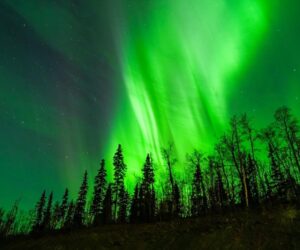PUNXSUTAWNEY, PA – FEBRUARY 2: Official groundhog handler Bill Deeley holds Punxsutawney Phil on February 2, 2006 in Punxsutawney, Pennsylvania. Every February 2, people gather at Gobbler’s Knob, a wooded knoll just outside of Punxsutawney to watch Punxsutawney Phil look for his shadow. If he sees his shadow, it means six more weeks of winter. If he does not see his shadow, it means spring is just around the corner. The legend of Groundhog Day is based on an old Scottish couplet: “If Candlemas Day is bright and clear, there’ll be two winters in the year.” (Photo by Jeff Swensen/Getty Images)
Getty Images
Scientific inquiry and advancements benefit society in so many ways. Vaccines, weather prediction models, artificial intelligence, or precision agriculture techniques are examples of how research and development translate to “So What?” Though always lurking, we seem to have an explosion of “keyboard or social media” rhetoric that pits scientific expertise against common sense. Using the lens of my scientific field of atmospheric sciences, I want to explore this conflict and offer some pathways forward.
I grew up in a small Georgia community where people took pride in common sense. During my youth, I recall hearing adults talking about using common sense or someone’s lack of it. What is common sense? It’s honestly one of those things that you kind of know it when you see it. Dictionary.com defined it as, “Sound practical judgment that is independent of specialized knowledge, training, or the like; normal native intelligence.” For example, common sense would dictate that someone should not stand in a golf course fairway holding a 4—iron in the middle of an electrical storm. You don’t need a doctorate in meteorology or public health to arrive at that conclusion.
MUNICH, Germany: Four golfers swarm into a little caddy car as they are surprised by a hailstorm during a golf tournament in Munich on 28 June 2005. The storm took ten minutes only, and the sportsmen continued their competition afterwards. AFP PHOTO DDP/JOERG KOCH GERMANY OUT (Photo credit should read JOERG KOCH/DDP/AFP via Getty Images)
DDP/AFP via Getty Images
Over the course of my thirty—ish years within the field of meteorology, I have tracked a subtle tension between weather expertise, climate knowledge, and common sense. Unlike nuclear physics or cardiology, people experience “meteorology” and “climate” daily. Whenever I mention my profession to someone in line at lunch, it often leads to thoughts about the weather or climate change. I doubt that a nuclear engineer gets a person’s suggestions on fuel rod technology as they order a sandwich.
The public has experiences with cold fronts, ominous cloud patterns, and seasonal temperatures. Cultural marinades have also likely exposed them to weather-predicting almanacs, traditions like Groundhog Day, or sayings about weather conditions passed on from generation to generation.
NEW ORLEANS – AUGUST 30: People walk through high water in front of the Superdome August 30, 2005 in New Orleans, Louisiana. Thousands of people are left homeless after Hurricane Katrina hit the area yesterday morning. (Photo by Mark Wilson/Getty Images)
Getty Images NA
Meteorology and climate science are very quantitative sciences that involve significant exposure to advance mathematics, physics, computational sciences, chemistry, and more. The atmosphere is a fluid within a rotating system with several external factors such as oceans, mountains, greenhouse gasses, landcover changes and more. As we approach the peak of the Atlantic hurricane season and reflect on the 20th anniversary of Hurricane Katrina, I will use hurricanes as an example of the clash between common sense and science.
Hurricane Erin rapidly intensified last weekend as it moved across the Atlantic Ocean. For many days, it was tracking on a path towards North Carolina. However, the weather prediction models and forecasters were in consensus that the storm would make a northeastward turn and head out to see. As I monitored popular social media sites, there were a litany of common—sense expert takes out there. Some people said, “There’s no way it is not going to turn, it is going make landfall in the U.S.” Others came up with false or illogical theories on the fly like, “They move how they want to when they get that strong, so it is going to go straight” or “It’s going to get to Category 6 soon.” By the way, there is no such thing as a Category 6 storm on the Saffir—Simpson Scale.
Climate model physical processes and grids.
NOAA
Examples Of Common—Sense Conflicts With Weather And Climate
Ultimately, Erin made the turn that we expected. The scientific models clearly indicated that it would, but the “common sense” lens on the storm fed other perceptions. I am the former president of the American Meteorological Society and serve as director of the atmospheric sciences program at the University of Georgia. I host the Weather Geeks podcast for the Weather Channel and spent twelve years as a research meteorologist at NASA Goddard Space Flight. I mention those things to establish that I have been a part of the weather community for a long time. Here are some of the more popular common—sense takes that I have corrected over the years:
- Heat lightning: It has been passed on to many people that when the sky is illuminating with lightning and no thunder that the heat of the day is somehow causing it. In reality, the lightning is too far away to hear the thunder. Remember, light travels much faster than sound.
- Climate has always changed: This is one that I commonly hear. Trust me, scientists like me know that. However, we also know that it is not “either/or.” It’s “and.” Grass grows naturally, but it also grows differently when you fertilize the lawn.
- It’s always hot in the summer so what’s the big deal?: This one is a bit of a challenge because people are familiar with seasons and understand that some months are supposed to be hot in the summer. The risk communication problem is that certain places may be 5 to 10 degrees warmer than they should be and that creates hazards. Yet, the common—sense detector may not recognize that it is hotter than the average expected conditions in late July or August. As I write this, extreme heat is prevalent in the western U.S. from Los Angeles to Seattle. It is creating a health hazard, affecting infrastructure, and boosting the wildfire threat.
- It’s snowing so how can climate be warming?: This is another very assertion rooted in the common—sense observation that snow is ice and associated with cold conditions. People confuse weather and climate often. Weather is your mood, and climate is your personality. The assumption that a snowy or cold day refutes the broader backdrop of climate indicates a lack of understanding that winter weather will still happen in a climate—warmed world and that there is nothing unusual about snow in Boston in February.
- Climate change is related to changes in the Sun: This is another tough one because most people think we survive on Earth exclusively because of the direct energy from “Mr. Sun.” If you had kids, you probably got that reference as the song now permeates through your brain, but I digress. Common sense tells people the sun is hot and delivers heat to the Earth. However, the science of the greenhouse effect provides the details of energy being absorbed and re-emitted by greenhouse gasses. That process is the reason we “survive” comfortably each night.
Greenhouse Effect illustrated.
NPS
- Tornadoes don’t hit cities. This myth has been around for a long time. In the grand scheme of things, urban areas are a small percentage of the landscape, so from a statistical standpoint, rural or open landscapes experience more tornadoes. As urban footprints continue to expand and weather radar capabilities advance, it is clear that tornadic activity is happening in cities too.
- It does not get cold in the desert. Umm, yes it does. However, people perceive deserts to be hot places, and they are. However, they are also places that can be quite cloud-free, which means as heat is radiated away from the ground at night, temperatures can cool substantially.
- Those cannot be condensation trails coming from airplanes because it is not that cold up there: A friend shared that a guy told him that because planes are flying closer to the Sun, it couldn’t possibly be cold enough for condensation trails to form. Ok, we’ll generously call that common sense, but the atmospheric cools as we go from the surface of the Earth to higher elevations or altitudes. Snow-capped mountains in the summer anyone?
- There was a 20% chance of rain, so it is not going to rain. That’s always baffling to me. It wasn’t 0%, so my interpretation is that there is certainly a slight chance that it could rain in the area, and if it does, that forecast was not incorrect. Your interpretation was.
I could go on with many other examples, but I hope you get the point about how common sense can clash with the science and lead to bad interpretations.
Condensation trails of airplanes are seen in the sky above the ski resort of Zauchensee, Austria on January 15, 2022. (Photo by Joe Klamar / AFP) (Photo by JOE KLAMAR/AFP via Getty Images)
AFP via Getty Images
How To Move Forward
At some point you have probably heard of K.I.S.S. and not the legendary rock band with the makeup. K.I.S.S. is an acronym for “Keep It Simple Stupid.” I think it shapes a lot of the conflict between science and common sense. Many people view science as methodical, complicated, and out of touch with specific problems. People often resonate with simple explanations that align with their own mental models, level of understanding, or belief system. This is also why conspiracy theories can spread widely.
People benefit from cellphones and computers every day but probably do not connect the dots that scientific research in physics, thermodynamics, and engineering enabled them. Science, technology, engineering, and mathematics professionals must continue to make the science accessible by knowing audiences, minimizing jargon, using analogies or real-world examples, and applying miniature, meaningful, and memorable (3M’s) messaging.
Using satnav app on a mobile phone while driving on M25 motorway, UK. (Photo by: Alex Segre/UCG/Universal Images Group via Getty Images)
UCG/Universal Images Group via Getty Images
Additionally, the public is bombarded with or has access to a lot of information in these days. In my experience, I have noticed that many people don’t understand that a video on the Internet, a post on social media, or an “official-looking” report may not be credible, vetted, or properly scrutinized by peers. Several years ago, I published a guide to consuming science information online. I strongly encourage everyone to revisit those principles periodically.
Trust is also important. Common sense is rooted in personal experiences and assessments, so people trust what they feel, think or see. This one can be a tough nut to crack because geographic, cultural, political, religious, and other types of marinades can shape experiences. I recently spoke to a group of peanut farmers about weather and climate risk. Farmers are critical to all of us, and I have so much respect for what they do. It is hard. Their livelihood and the products that come from their seeds are strongly dependent on weather and climate.
Because I knew there were multiple viewpoints likely in the room, I framed my discussion in a way that gained trust. I said something like, “My experiences and the data give me a good sense of what’s going on. However, whatever you think is or is not causing them, our farmers are going to face storms like Hurricane Helene or Hurricane Michael again. I’d rather discuss how to make them more resilient rather than debate what you believe is causing it”
A 2025 study in the journal Nature Human Behavior examined trust in scientists around the world. Encouragingly, it is moderately high, particularly in the U.S. However, a 2024 Pew Research Center study signaled caution. While it found that the American public’s confidence increased to 76%, it was still down compared to pre-pandemic years. The study also revealed that 52% of the respondents felt that scientists were poor communicators, and 47% felt that scientists come across as superior to others. Though some of the results varied by political identify, race, and ethnicity, there are certainly lessons in these numbers too.
I have advanced degrees and am a member of three national—level academies. However, I am equally proud of my grounding in common sense. I am just as comfortable testifying before the House Science Committee in Washington, D.C. as I am cracking open boiled peanuts with a local farmer along the side of a country Georgia road.
Rear view of adult male operating peanut digger pulling up row of peanut plants to dry in sun, Tifton, Georgia. (Photo by: Edwin Remsberg / VWPics/Universal Images Group via Getty Images)
VW Pics/Universal Images Group via Getty Images









